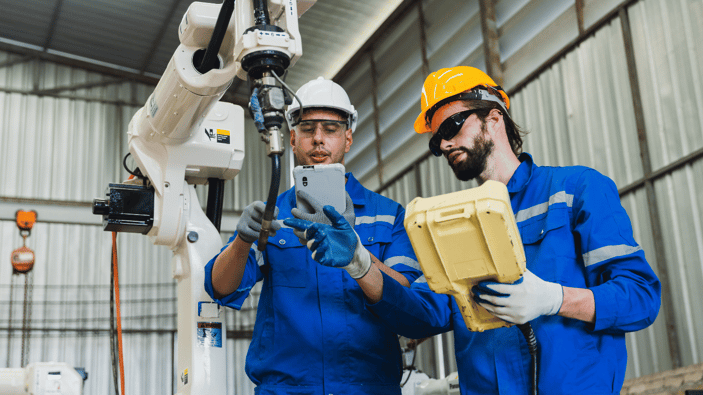Ever wonder how a city runs smoothly? It's like an orchestra, every instrument playing its part perfectly. Imagine being the conductor of this symphony - that's what it feels like to be in facility management. But here's where it gets tricky: How do you keep track of everything and ensure nothing falls through the cracks?
This is where our secret weapon comes into play - CMMS software. Picture yourself at the helm with a powerful tool capable of turning chaos into harmony.
"But wait!" I hear you say, "What on earth is CMMS?"
software is a real lifesaver. CMMS allows you to remain up-to-date on your assignments and provides an understanding of the condition of your possessions. With CMMS, not only can you manage day-to-day operations efficiently, but also predict potential issues before they turn into costly repairs.
Understanding Facility Management and its Relevance

The business world today needs more than just a well-structured plan to thrive. Creating an atmosphere that boosts efficiency, comfortability, security, and sustainability is essential in the present business world. This is where facility management (FM) comes into play.
ISO 41011, the international standard for FM, defines it as an organizational function that integrates people, places, and processes within the built environment to improve the quality of life of people and enhance organizational effectiveness.
The Diverse Roles of Facility Managers
A key player in this setup is a facility manager. With diverse roles ranging from building operations to project management - they ensure that every part fits perfectly in your company's jigsaw puzzle.
Imagine being at work without worrying about mundane things like faulty ACs or inadequate lighting – seems ideal, right? That's what good facility managers do. They create conducive environments so employees can focus on their core tasks rather than dealing with minor disruptions. They handle everything from return-to-work processes after emergencies to long-term sustainability planning.
Not only do they take care of emergency responses, but they also have strategic responsibilities such as business continuity planning and ensuring smooth operations no matter what curveballs are thrown their way.
Beyond handling daily issues, these professionals strategize around future space needs while balancing costs & employee satisfaction—essentially making sure everyone gets what they need when they need it without breaking the bank. The bottom line? A great facilities manager equals happy employees, which translates into higher efficiency and productivity for your organization.
The Role of CMMS Software in Facility Management

Computerized Maintenance Management System (CMMS) software is an indispensable tool for modern facility management. Its primary function is streamlining maintenance operations, turning a potentially chaotic process into a well-oiled machine.
The Functionality of CMMS Software
A robust CMMS solution offers more than just tracking and editing capabilities. The engine drives preventive and predictive maintenance strategies by generating work orders, creating reports, and delivering actionable insights from data analytics.
This innovative technology helps facilities manage their assets better by providing a centralized system to track all aspects of maintenance scheduling - think tasks as simple as replacing light bulbs to more complex jobs like HVAC system overhauls.
No matter the size of the company or type of built environment you're managing, effective use of this software can significantly improve operational efficiency while reducing downtime - two factors directly linked to improved customer satisfaction levels.
Many facility managers rely on CMMS software solutions because they make it easier to keep tabs on labor hours spent per task or project. Analyzing these metrics regularly using built-in tools within the platform itself allows them to fine-tune processes, which ultimately leads to lower labor costs without sacrificing service quality.
Making Sense Out Of Chaos With Work Order Management
To further understand how crucial CMMS systems are for smooth operation, let's consider work order management – one aspect where benefits shine brightly. Imagine your organization getting bombarded with hundreds, even thousands, requests each day – be it repair requirements, new installations, scheduled check-ups, etc., trying to handle this volume would seem like herding cats.
But with reliable computerized maintenance management solutions, every request gets logged systematically and assigned to appropriate maintenance teams. It's an organized, efficient method that not only keeps operations running smoothly but also minimizes the risk of tasks being overlooked.
When you start exploring how to get the most from your CMMS, remember it's all about optimization – whether we're talking time, resources, or efforts. This way, facilities can maintain their assets better while ensuring top-notch service quality, thereby improving the overall business operations.
| With CMMS software, facility management becomes a breeze. It turns maintenance operations into streamlined processes by driving preventive and predictive strategies. This software also manages work orders efficiently, generates comprehensive reports, and provides valuable insights through data analytics. The result? Improved operational efficiency and reduced downtime - which means happier customers. Plus, it's a crucial tool when dealing with large volumes of work orders. |
Benefits of Using CMMS Software in Facility Management
In the dynamic world of facility management, using a Computerized Maintenance Management System (CMMS) is like having an ace up your sleeve. This powerful tool doesn't just make work more manageable; it transforms how you manage maintenance operations.
Cost-Effective Solutions with CMMS
A significant benefit that stands out when discussing CMMS software solutions is cost-effectiveness. Picture this: equipment failure strikes unexpectedly, and repair costs skyrocket because spare parts are unavailable or obsolete. Sounds stressful? Well, here's where CMMS shines.
The system not only alerts you about impending equipment failures but also keeps track of inventory levels for critical spare parts - all. At the same time, ensuring predictive maintenance tasks are scheduled to reduce downtime. These capabilities save precious labor hours and prevent unnecessary expenditure on emergency repairs.
This ability to streamline processes directly impacts your bottom line by reducing overall operational expenses.
You may ask yourself, "Can any size company use a CMMS?" The answer is a resounding yes. Whether you're managing facilities for a small business or overseeing asset management at the enterprise level, no doubt implementing these systems can offer substantial benefits.
Maintenance Scheduling Made Easy
Beyond cost savings, another advantage lies in preventive maintenance scheduling, which can extend asset life significantly – now, isn't that something we'd all want? Think less reactive firefighting and more proactive planning – ensuring assets run smoothly before issues become expensive problems.
Through streamlined work order management and automated service request processing abilities provided by most software solution providers today, you can be sure of improved maintenance team productivity and customer satisfaction.
Remember, the key to successful CMMS implementation lies in thorough training for both facility managers and maintenance workers. With proper usage, a CMMS becomes an invaluable tool that not only enhances your management process but also makes work orders seem like less of a chore.
| Picture the power of CMMS software transforming your facility management. Not only does it make tasks more manageable, but it also brings cost-effective solutions by preventing unexpected equipment failures and reducing operational expenses. It's a tool that any size company can use for improved maintenance scheduling, extending asset life significantly, and boosting team productivity and customer satisfaction. |
Choosing the Right CMMS Software for Efficient Facility Management
Picking the perfect CMMS software solution can feel like searching for a needle in a haystack. But it's crucial to find one that aligns with your facility management needs.
Factors to Consider When Choosing a CMMS
The market today is flooded with options. So, how do you narrow down your choices? Let's start by looking at what you need from maintenance management software.
Your top priority should be creating reports that help analyze data and make informed decisions about asset work and routine maintenance scheduling. Surprisingly, many companies miss out on this benefit of their CMMS software.
You also want something user-friendly that simplifies keeping track of daily tasks such as service requests or tracking spare parts inventory levels - features that not every product offers but are essential to manage maintenance operations effectively.
Last, don't overlook customer satisfaction when considering potential vendors. This might seem unrelated at first glance, but remember: happy customers often mean high-quality products. You wouldn't buy any other product without checking reviews first; why should your choice of enterprise asset management system be any different?
Nailing Down Your Needs
Beyond these primary considerations, there are more specific aspects related to individual business requirements – after all, no two facilities operate identically. It's, therefore, vital to choose an EAM software explicitly suited for the size of the company you have or even tailor-made solutions if necessary.
This involves understanding what it means to say 'maintenance management process.' For instance, does yours affect more preventive than reactive repair? Do specific equipment downtime periods cause significant disruptions? What labor hours are involved in your maintenance scheduling?
Questioning these matters can assist you in selecting the most suitable option. Remember, the goal isn't to get lost in a sea of software solutions but rather to use CMMS as an aid that simplifies and streamlines processes while keeping assets running smoothly.
Consider The Future
think about where you see your business's facility management heading. Will there be growth or changes that could influence which system is ideal? Considering the future implications of facility management, it is essential to plan for potential growth and changes that could affect which method is most suitable.
|
Choosing the perfect CMMS software for your facility management is like finding a needle in a haystack. Start by identifying what you need - user-friendly features, detailed reports, and positive customer reviews are vital considerations. But don't stop there; think about specific business needs and future growth plans. Remember, it's not just about picking any solution but one that simplifies tasks, meets your unique requirements, and has room to accommodate your goals as you expand. |
How CMMS Software Helps Facility Managers

A CMMS is an invaluable tool for facility managers, enabling them to efficiently manage service requests, track assets, and optimize maintenance operations in real-time. With the proper setup, it lets you manage service requests, track assets, and streamline maintenance operations in real-time.
The U.S. Bureau of Labor Statistics states that properly implementing a CMMS involves getting everyone on board, building an extensive database, and providing adequate training. These steps are crucial to unlock its full potential.
Streamlining Service Requests
The daily life of a facility manager is filled with numerous tasks requiring immediate attention. From maintaining asset life to handling work orders - it's like juggling fireballs. But here's where CMMS software comes into play.
A good quality CMMS solution, like MicroMain, for instance, allows you to efficiently handle all service requests by digitizing them onto one platform. This saves time spent on paperwork while also ensuring no request slips through the cracks.
Easing Asset Management
Another critical role played by any decent CMMS is in asset management: keeping track of equipment downtime and inventory levels becomes much easier when digitally recorded within your software system.
This simplifies preventive maintenance scheduling, which ultimately reduces costs associated with labor hours and spare parts usage. Plus, as per studies conducted by leading market analysts today - companies using these tools experience significant improvements in their overall customer satisfaction scores, too.
Maintenance Scheduling Made Simple
Schedule work or routine repair history tracking could sometimes get overwhelming without an organized approach but fear not. A well-implemented CMMS helps automate this process entirely - thus freeing up time for facility managers to focus more on strategic initiatives that matter.
So, if you're looking to reduce downtime and increase efficiency in your built environment, it's worth giving CMMS serious consideration. Remember - it's not just about the software itself; it's how well you use it.
|
CMMS software can revolutionize your facility management. It digitizes service requests, streamlines maintenance operations, and eases asset tracking in real-time. To get the most out of it, you need a well-built database and proper training for everyone involved. The correct implementation will save time on paperwork and reduce downtime and costs associated with labor hours or spare parts usage while enhancing overall efficiency. |
Maximizing Facility Management with CMMS Software
Regarding facility management, CMMS software solutions have proven their worth. But how can we squeeze out more benefits from these tools? The answer lies in training and informed decision-making.
The Role of Training in Maximizing Benefits from a CMMS
IFMA Programs and Services, for instance, provide comprehensive resources on getting the most out of your CMMS solution. It's no secret that proper setup and utilization of a well-chosen CMS system can significantly improve business operations. This isn't just an assumption; data backs this up.
Ensuring everyone comprehends the CMS is essential. When members know how to generate work orders or analyze maintenance scheduling data, they become more efficient at managing daily tasks.
This isn't limited to maintenance teams but extends even further to include other stakeholders like asset managers, who are often tasked with ensuring assets' longevity by minimizing equipment downtime through preventive maintenance measures made possible by accurate repair history tracking using CMMS software solutions.
To make things easier for all involved parties - including service request submitters (typically customers) whose satisfaction is directly tied into smooth-running processes - modern-day enterprise asset management systems integrate seamless customer-facing interfaces, allowing users to lodge issues quickly while providing them updates about resolution progress in real-time.
However, adopting new technology always brings challenges along – mainly related to people's resistance towards change due to its perceived complexity, causing anxiety among workers, which then hinders successful implementation, leading organizations to miss potential benefits they could achieve if appropriately implemented.
This leads us back full circle: Training doesn't simply mean learning tool's functions but rather understanding its value across organizations, starting a top-down approach where leaders must take the initiative to set the right tone regarding the importance technology plays today's business landscape, thereby fostering positive attitudes towards adoption among employees.
So, before we dive into any advanced features of your CMMS or EAM software solution, let's get the basics right first - because that's where actual maximization starts.
|
Getting the most out of your CMMS software isn't just about using it but understanding its value and integrating it into daily operations. Comprehensive training helps ensure everyone knows how to use the system efficiently. Plus, adopting a top-down approach encourages positive attitudes toward tech adoption among employees. |
Future Trends in Facility Management and CMMS Software

The landscape of facility management is ever-evolving, with technological advancements continually reshaping the sector. One tool that's proving instrumental in this evolution is Computerized Maintenance Management System (CMMS) software.
The Role of AI and IoT in the Future of CMMS
AI (Artificial Intelligence) and IoT (Internet of Things), two emerging technologies, are essential for the advancement of CMMS (Computerized Maintenance Management System) software, as well as providing enhanced efficiency, predictive power, and automation in facilities management. They offer the potential for even more efficiency, predictive power, and automation within facilities management.
AI can now swiftly assess an abundance of data, more so than ever before. This ability could enable quicker decision-making processes regarding maintenance tasks - leading to reduced equipment downtime, improved preventive maintenance scheduling, and better asset life expectancy calculation - ultimately increasing overall productivity.
IoT devices can communicate directly with a CMMS system via sensors installed on assets or equipment. These smart devices provide real-time updates about an asset's condition, allowing facility managers to monitor everything from temperature changes to vibrations – detecting issues before they become costly problems. Such integration helps streamline work order management by automatically generating service requests when anomalies are detected.
This proactive approach not only increases customer satisfaction but also enhances operational efficiency by reducing labor hours spent manually inspecting each piece of equipment.
Apart from boosting daily operations' effectiveness at a micro level, these trends also contribute to shaping strategic decisions at a macro level. With increased visibility into assets' performance through robust reporting features provided by advanced Enterprise Asset Management (EAM) software, facility managers can make more informed decisions about asset management and replacement strategies.
While we are only at the tip of the iceberg regarding what AI and IoT integration with CMMS software could achieve, it's clear that these future trends can revolutionize how facility maintenance is conducted. As technology continues to evolve, so will our methods for maintaining assets – leading us into an exciting new era in facility management.
|
As we step into an exciting new era of facility management, AI and IoT are taking center stage in CMMS software. This potent tech duo allows for faster data analysis, quicker decision-making, improved maintenance predictions, and increased task automation. The end game? Minimizing equipment downtime and labor hours while maximizing productivity and customer satisfaction with the assistance of this innovative maintenance software. On top of that, these advancements are actively shaping the future landscape of strategic asset management. |
Conclusion
It's a fact: CMMS facility software is revolutionizing how maintenance managers and facility professionals approach facility maintenance and address maintenance issues. With this CMMS facility software, managing assets, scheduling maintenance tasks, and keeping track of work orders becomes effortless. This powerful tool not only streamlines operations but also predicts potential maintenance issues before they morph into expensive repairs, helping reduce costs.
You've learned how it enhances customer satisfaction by ensuring efficient service request handling and boosts your bottom line by reducing equipment downtime. The power to maximize facility management with CMMS facility software is in your hands - use it wisely to simplify maintenance.
Remember, selecting the right solution for your business needs is crucial; thorough training ensures you extract maximum benefits from your chosen system. Stay ahead of trends like AI integration in CMMS as technology evolves. Keep innovating because successful facility management isn't about maintaining the status quo—it's about improving daily!
 For immediate assistance, please call us at (512) 328-3235
For immediate assistance, please call us at (512) 328-3235



